Mirar esta página en español HomeJournal ContentsIssue Contents
Volume 12 Number 1
©The Author(s) 2010
A Valuable Experience for Children: The Dim Sum and Chinese Restaurant Project
Abstract
This article describes the Dim Sum and Chinese Restaurant Project undertaken by 6-year-old kindergarten children in Hong Kong. The article discusses the importance of listening, observing, and documenting children’s actions to meet their needs and interests.
Background
The School and the Children
The kindergarten program that participated in this project is located on the Hong Kong Island. It is a nonprofit kindergarten organized by a Christian church. There were 20 female teachers whose working experiences in kindergarten ranged from 2 to 20 years. They were all qualified kindergarten teachers. Sixteen teachers were graduates of the Qualified Kindergarten Training Program, an inservice one-year basic course requiring about 6 hours of study per week. Four of them had a Certificate of Kindergarten Teacher Education, a 3-year inservice course requiring about 6 hours of study per week. Each classroom had two teachers and a teacher assistant. Four hundred 3- to 6-year-old children were enrolled in the kindergarten in the school, about half of whom attended 3-hour sessions in the morning and the rest in the afternoon. The children came from middle- or upper-middle-class families. The 30 children who undertook this project belonged to a 6-year-old class. The class worked on the project 2 hours each day for 3 weeks.
Project Background
The kindergarten principal invited the author to be a school consultant in a 2-year school improvement project. Working within the context of a school improvement project in kindergarten, the author responded to the parents’ and teachers’ concerns about the children’s growth and learning and conducted a case study of a school-based initiative to engage parents in supporting their children’s learning. In the past, the kindergarten used a thematic approach in which the teachers planned the curriculum, and the teaching process was teacher directed. As a result of a discussion between parents and teachers, it was determined that the teachers hoped to strengthen the children’s motivation to learn and their abilities to solve problems, whereas the parents wanted their children to share their school lives with them. Thus, the school curriculum changed to use a mixed curriculum of Project Approach topics and thematic units.
Parents and teachers agreed to try a project-based learning approach wherein the children would direct their own learning based on their interests and would search for relevant information and materials to support their explorations. In addition, the children were encouraged to integrate drawing and writing daily newsletters to communicate to their parents what they needed and how their parents could help them. Thus, the classroom activities shifted away from teacher-centered lessons toward an emphasis on learning activities that were interdisciplinary, student centered, and integrated with real-world issues and practices.
This is the first year that the teachers have used the Project Approach. Throughout the development of this project, parents participated closely with the teachers by collecting material and information, and by making a site visit. The teachers sought to create an environment wherein adults and children could learn together and children’s knowledge and skills could be extended by encouraging critical reflection and offering feedback. In the Project Approach, the teachers’ role is complex and includes adopting the role of a listener, prompter, information giver, and asker of questions interesting to the communication process. During this project, the conversations between the teachers and the children focused on stimulating inquiry, helping children who were trying to write or draw something they had in mind, reading back children’s ideas, and searching with them for insights that would motivate further questions and group activity. The teachers also communicated with the parents about the project and encouraged them to become involved in their children’s activities by finding the necessary materials for children to use during the project.
The author was responsible for providing teacher training in implementing a project-based learning approach and for evaluating the project.
The teachers at the school teamed up to discuss the curriculum, learning activities, and evaluation of the project in six group sessions. The first three learning sessions’ themes included (1) inquiry teaching, (2) self-reflection, and (3) parent involvement. Teachers met every week during the project. A review time was held that enabled the teaching team to conduct a process recall, reflect on their experiences, and plan for the coming session. Such discussions also engendered a knowledge-creation process. They had three sessions on sharing and reflection. At the middle and the end of the project, a review time was held to allow the parents to discuss and share their experiences.
Emerging Project
As the school year began, three teachers were working on a “China” theme. The topic was quickly moving to chopsticks and Chinese food. During a discussion, Lee Yim shouted out, “I go to a Chinese restaurant every Sunday with my parents. I like spring rolls.” Another boy said, “I like all the dim sums, it is yummy!” All of the children then began to tell their personal experiences.
Lai Pui’s restaurant experience was typical of the stories children shared:
Sunday, I always go to a restaurant with my parents and grandparents. When we are seated, Dad often takes the order for us. He “clicks” the dim sums that we want to eat on the dim sum card. Dad knows I like spring rolls and granddad likes wonton dumpling. About 10 minutes later, a woman brings the dim sums to our table. Then we are enjoying the hottest dim sums and talking together. When we are finished, Mom pays the bill. And then we go home or to the park.
Chinese restaurants begin serving dim sum as early as 5:00 in the morning and continue through mid-afternoon. When you are first seated, the waitress will hand you a dim sum order form/card, and you use a pencil to mark off which items you want and the number of orders. The food is served at the table in steamer baskets to keep it warm. Restaurants that continue to use the traditional cart system, including a major restaurant chain in Hong Kong, have made this a selling point. Many of the dishes are either steamed or deep fat fried. Among the former, you will find steamed buns with roast pork, shrimp dumplings wrapped in seaweed, steamed beef balls, chicken’s feet, and turnip cake. The deep-fried treats include mini spring rolls and wonton dumplings.
The teachers wrote down the children’s experience and ideas in the form of a web (as shown in Figure 1) and found that the children had a broad knowledge base related to Chinese restaurants.

Figure 1. Teachers’ web about dim sum and Chinese restaurants based on the children’s conversations about the topic.
Phase 1
As the children were engaged in excited discussion, Chi Wing suggested, “We can open a Chinese restaurant.” The teacher asked what the Chinese restaurant could look like. The children all had very positive responses to the topic. Their conversation about the Chinese restaurant went as follows:
Hung: It is very big, has 50 tables, over 100 chairs and lights.
Wing: It has a big kitchen, also has many steamer baskets and dim sum carts.
Lui: Many, many “yummy” dim sums, such as spring rolls, steamed barbecued pork bun, turnip cake, wonton and…
Chi Ming: And a cashier counter.
Chan: There is a hostess standing in front of the restaurant.
Sam: Yeah. Everyone wears uniforms having the same logo and name of the restaurant on it. But we need many people to act as customers, cooks, hostesses, and waiters/waitresses and…
Ricky: No problem! We have 30 classmates, we can divide into different subgroups as we played the drama last time.
Ricky’s idea was well received by the children. Everything they initiated continued to lead them to “The Dim Sum and Chinese Restaurant Project.”
After many conversations, the children agreed that they needed to find more information about restaurants before trying to open their own restaurant. This process brought the class together as they discussed what resources would be required. The class created a list of items that they wanted to add to the classroom for the project and a list of possible ways that their parents could be involved. The children decided that parents could help them to collect the “dim sum order form/card,” “seat allocation paper,” “dim sum photographs,” and “steamer baskets.”
It is not easy to arrange a site visit away from school, so the children decided to make a daily newsletter asking their parents to take them to a Chinese restaurant on the weekend and inviting the parents to collect materials that they needed.
The next Monday, the class gathered on the carpet to share their new information about Chinese restaurants. Twenty-four children had visited a Chinese restaurant with their families. They had observed all the things happening in restaurants in more depth, including waiters’/waitresses’ uniforms, hostess’s job, table settings, table reservations, and taking orders. The discussion and sharing turned out to be valuable because, as the children were shaping and molding the different parts of their own restaurant, different ideas about what they needed came up during the conversation. They noticed that they needed space for the kitchen, the hostess table, and the cashier counter. Liu On realized that the tables needed table numbers and some decorations as well. In addition, some children had collected the steamer baskets, dim sum order forms/cards, and seat allocation papers, and they brought those artifacts back to school. Yip Wan brought a small tray and pretend coins for customers paying the bill. The children decided to use all these ideas to create their restaurant. They had a lot of work to do, and there was no stopping them.

Figure 2. Fun counting bamboo sticks of a steamer basket.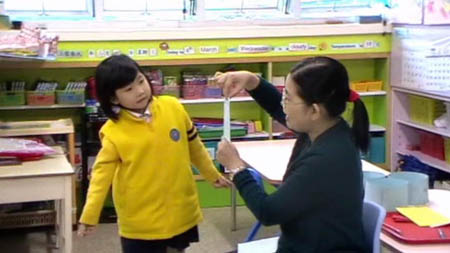
Figure 3. Lok explaining dim sum card she collected.
Phase 2
The children were divided into subgroups based on the roles that they wanted to have in the restaurant. Some wanted to serve at the restaurant; some wanted to be customers. Both roles required them to investigate and solve problems. They first needed to figure out how many people the restaurant would serve and how many tables they could set in their classroom. Lastly, they decided that their restaurant would have a hostess, 8 waiters/waitresses, 3 cooks, 3 children as the dim sum serving crew, and a cashier. The remaining 24 children were the customers being served at 6 tables.
The children were able to role-play, pretending to be the customers and the hostess at the restaurant. When Yu Hing was playing hostess, the following conservation took place.
Yu Hing: Good Morning! How many people together?
Ricky: Four.
Yu Hing: Table number 23, go inside and turn left, please.
Ricky & Wing Man: Thanks!
The children talked about their experience with the waiters/waitresses on the weekend:
Jim: They were very busy. They set up the tables by putting out chopsticks, bowls, and spoons.
Wah Fai: As soon as the customers were seated, they served Chinese tea and took orders for the customers.
Chi: Then they went to the kitchen and filled the order.
Hung: They also needed to clean up the tables as the customers paid the bills.
Fung: And they spoke politely, such as “What would you like to eat?” “What can I help you with?” “What kinds of tea you want to have?”
Sun Wing: They stayed awake! They checked on their customers every chance they got to make sure they had everything they needed.
The children became interested in role-playing. After the previous sharing and role-playing, the children who were acting as waiters/waitresses learned that setting up the tables, serving Chinese tea, taking orders, cleaning up the tables, and giving good customer service are parts of a waitperson's job. 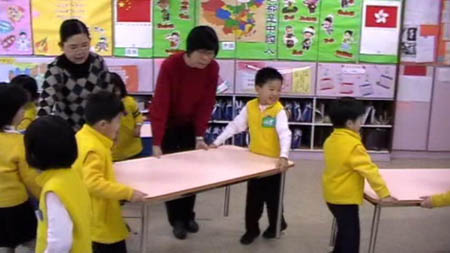
Figure 4. Moving the tables. 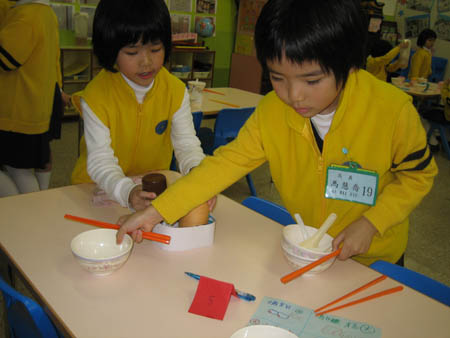
Figure 5. Setting up the tables.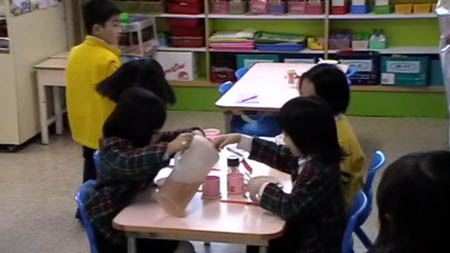
Figure 6. Sitting in the restaurant.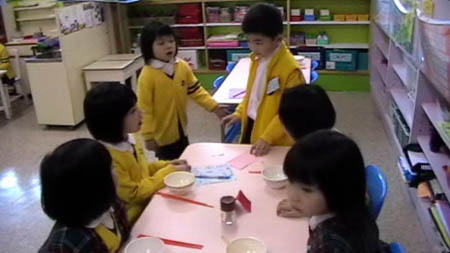
Figure 7. Waiter and waitress serving customers.
The customers and cashier decided to suggest names for the restaurant. They also discussed how to make the dim sum order and record forms. The following conversation was typical of those that I recorded as children discussed possible names for the restaurant:
Chi: What is the name of our restaurant?
Win Man: Happiness Restaurant.
Sum Sam: No, Big Sun Restaurant.
Chan: Great Ocean Restaurant.
Lee Wing: Yeah! We can vote on the best name by the class.
After many group brainstorming and voting sessions, the children decided on the restaurant’s name: The Big Happiness Restaurant. The name was quite meaningful to the children because they wanted all customers to feel happy after being served.
The group of cooks and dim sum serving crew were responsible for preparing the food. The cooks decided to serve four types of dim sum (spring rolls, steamed barbecued pork bun, wonton dumplings, and steamed turnip cake) so that they could prepare the food in advance. They all made dim sum order cards out of recycled paper and even prepared “paper” food for their customers. Some children cut the dim sum photographs from advertisements; some drew the different types of dim sum by themselves.
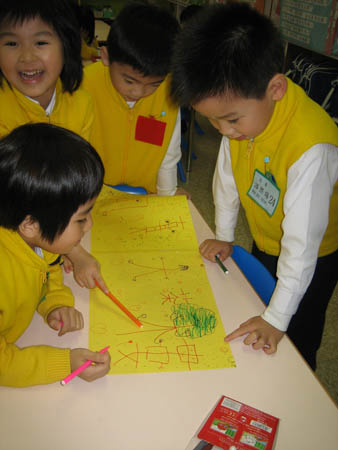
Figure 8. Discussing the name of the restaurant.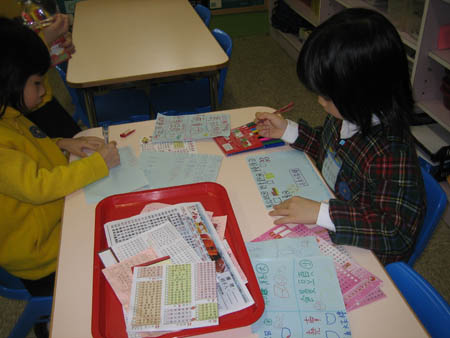
Figure 9. Making dim sum order cards.
This activity seemed to motivate the children’s involvement and provided opportunities for them to use their math problem-solving skills. Here is one of their questions:
Hung: Why is the dim sum put on a special steamer basket?
Fun: Yes, it keeps the dim sum warm and is made of bamboo.
Wah Fai: They are all round in shape. They have bigger and smaller ones.
Sun Wing immediately added that he saw a program titled Making Dim Sum Steamer Baskets on educational television. Teachers accessed the program over the Internet. The program answered all the children’s questions. Children decided to make their steamer baskets as the program demonstrated.
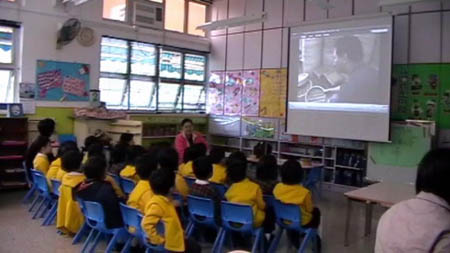
Figure 10. The children watching the television program.
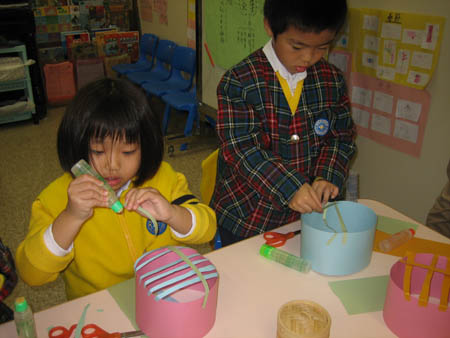
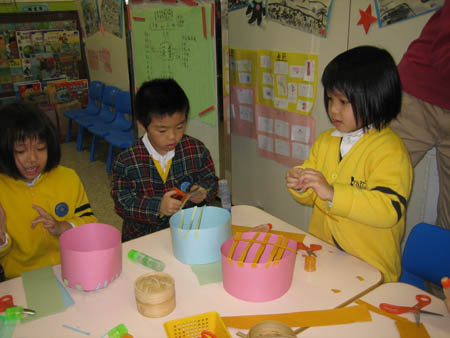 Figures 11-12. Preparing steamer baskets.
Figures 11-12. Preparing steamer baskets.
Ming: It is 10 sticks in a row, I counted already!
Chi: Yes, and two sticks in a column. Otherwise, the dim sum will fall down.
Another conversation centered on how many baskets to make:
Oil Lan: How many dim sums do we need to make?
Ming: 4 types of dim sum, 6 tables…Hi! Hi!
Chan: We’ll need 24, because 4+4+4+4+4+4 is 24.
Lee: How did you figure that out?
Chan: I counted by 4s.
Chui Yan: Oh! We need 24 steamer baskets, too.
Phase 3
The big day finally arrived for our grand opening. The children were excited about their restaurant. There was a lot of work ahead of them. The children decided to divide into three subgroups: (1) the customers, (2) the waiters/waitresses, and (3) the cooks, dim sum serving crew, hostess, and cashier. The three groups rotated every day, ensuring that each child had experienced different roles over four days of restaurant play. The waiters/waitresses needed to set tables, including putting chopsticks, bowls, and a table number card on each table. The three cooks prepared and organized the food beforehand in order to offer quicker service. When the customers arrived, a hostess greeted them. They were welcomed to a clean and comfortable restaurant.

Figure 13. Hostess taking reservations.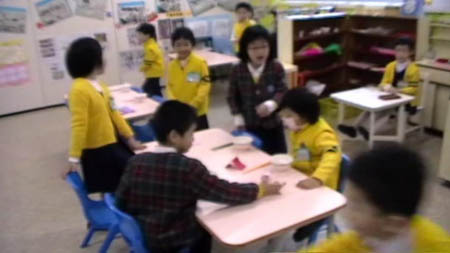
Figure 14. Waitress leading customers to the table.
As soon as the customers were seated, the waiters/waitresses served them with Chinese tea. Then they took the customer’s dim sum order card, marked the table’s number on it, and sent the card to the kitchen. Just like the real waiters and waitresses they had observed, the children would check every chance they got to make sure their customers had everything they needed.
The cooks prepared the dim sum, and the dim sum crew served customers based on their orders.

Figure 15. Cooks and dim sum crew preparing food.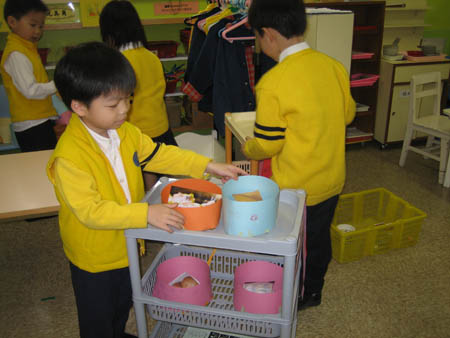
Figure 16. Serving the food.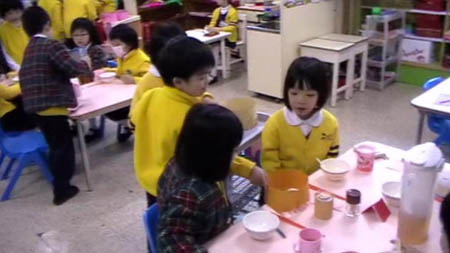
Figure 17. Serving the customers.
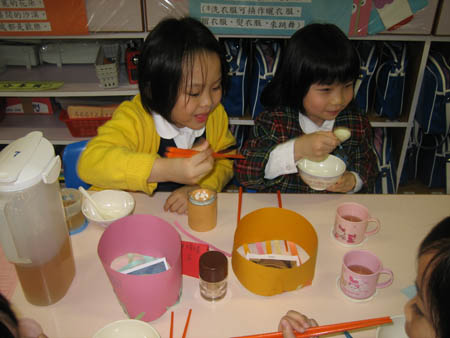
Figure 18. Enjoying the food.
The cashier had to figure out the meal total and give change to the customers at a relatively fast pace because many customers had to go.
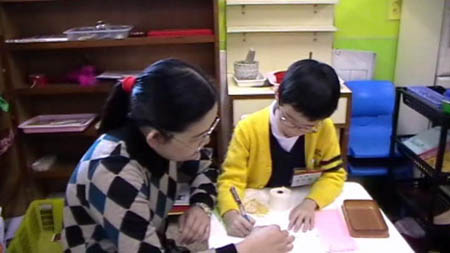
Figure 19. Teacher and cashier checking the calculation.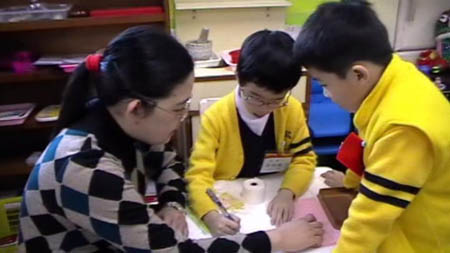
Figure 20. Waiter bringing bill and money to the cashier.
Being a waiter or a cashier at the Big Happiness Restaurant involved solving mathematical problems. A teacher had the following conversation with a cashier and one of the waiters:
Jun (teacher): Do you have a problem?
Chi Wai (cashier): The customers ate three types of dim sum. Each type is 3 dollars, 3 + 3 is 6, 6 + 3 is 9.
Jun: It’s right, good job.
Chi (waiter): Here is the money.
Chi Wai (cashier): 20 – 12 is 8, here is the change.
Chi (waiter): Exactly, you are a good cashier.
After the customers had paid the bills and gone, the waiters/waitresses were also responsible for cleaning up the tables.
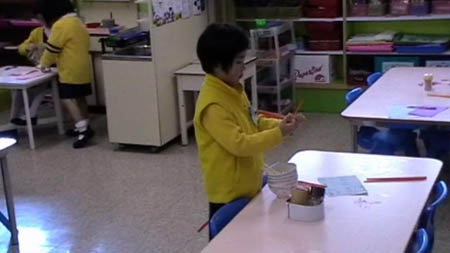
Figure 21. Waitresses cleaning tables.
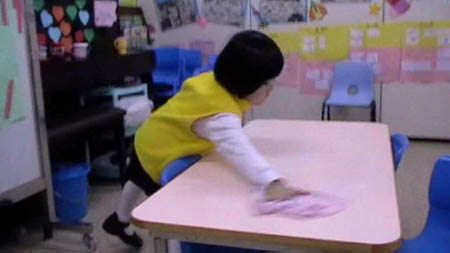
Figure 22. Wiping a table.
Reflections
Katz and Chard (2000) point out that the Project Approach introduces opportunities for children to engage in investigation as part of the work undertaken in their classrooms. The early years are important years for all aspects of development. Children’s natural dispositions to be intellectually curious and to investigate their environments emerge (Katz, 1995). They learn about the uses of reading and writing, and they become motivated to develop and use a wide variety of related skills. It is therefore important that they have an opportunity to experience active, engaged learning.
In this project, the children were learning a lot about the different areas in a Chinese restaurant and ways of serving customers in their establishment, the Big Happiness Restaurant. They began to represent concepts and ideas through sharing their actual experiences—their visits to restaurants with their families and their work together to make a restaurant in the classroom. The project work also strengthened the children’s motivation to read signs and dim sum order forms and cards to find information and to answer the questions generated in the project. The project provided a purpose for representation. As the children’s conversations demonstrate, it caused many children to want to represent their ideas, observations, and solutions to problems that arose.
The children were consistently challenged during project work to solve mathematical problems and think scientifically, for example when they calculated the total amounts of dim sum and the bills, predicted the number of customers, and considered spatial relationships as they set up the tables in the classroom. This project created a reason to quantify information as they gathered it and to represent quantities with numerals. The children learned to use a variety of tools for investigation (including firsthand observations and the information from a television program) and to experiment and observe the results (e.g., the special design of steamer baskets).
The children displayed a variety of social skills as the work progressed. They exchanged ideas and opinions, shared responsibility for posing questions to others, and offered suggestions, corrections, and encouragement to one another to try something again if they were unsuccessful the first time. All of these interactions took place during genuine encounters about things that mattered to them.
The day after the Big Happiness Restaurant culminating activity, teachers asked children if they wanted to share their experience. Here are some children’s reflections:
Chan (Cook): I had a lot of fun. I loved being a cook. I found that some waiters/waitresses forgot to write the table’s number. It brought us a lot of trouble. We didn’t know where to send the food.
Ming: Yeah! After we found the problem, we checked all the details as waiters/waitresses sent the order to us. If they (waiters/waitresses) forgot, we asked them to go back and write the exact table’s number. Everything is solved.

Figure 23. A cook sharing his experience.

Figure 24. A waitress talking to the class.
Choi Wai (Waitress): The waiters/waitresses were having a lot to remember, including serving tea and taking orders. After working for a while, I could do very well. I really enjoyed serving the customers. I had a wonderful time doing it, and with my team.
Sum (Customer): The dim sums were tasty and yummy. The waiters/waitresses were polite. I like the restaurant.
Chi Wai (cashier): I had nothing to do at the very beginning; however, customers asked for their checks all at the same time. I had difficulty figuring out the meal total and giving change to the customers at a relatively fast pace because many customers had to go back. If I had a calculator, it would be very helpful.
Wing: I have a calculator. I can bring it back tomorrow.
Two teachers also reflected on their experience after the project. Jun, who had over 15 years’ experience in teaching young children, commented:
I found that the more-experienced teachers struggled to adopt our teaching model as they attempted to facilitate and scaffold the children’s learning. Every day brought confusion and presented a brand new challenge. I maintained that my primary role as teacher was to lead and challenge children to develop the ability to puzzle over and question their work and to move toward a deeper engagement with their interests. In the project, children were motivated to learn because the topic was meaningful to them. I believe that this motivation should be sustained throughout the project as the children raise questions and plan activities and outcomes.… I know that children learn best by exploring their world directly. The project places emphasis on firsthand experience before secondary sources of information are introduced. Children can make more sense of secondary information if they already have experience with a subject through discussion with peers and adults, questioning, and a workable vocabulary…. I learned more than the children—as we were teaching the children, they were teaching us! I think that this project is going to be very beneficial both for the children and me.
Esther, who had four years’ teaching experience, said:
I really agreed with the child-centered approach. Our project allowed children to use all the skills and dispositions that they will need in order to tackle any problem or question throughout their lives…. We must listen to children and be more responsive to their ideas, feelings, and the exciting new ways of perceiving the world that they can offer us. We must respect children as partners in inquiry. I think this project and the Project Approach are going to be beneficial. I cannot see teaching any other way.
The parents were a great resource in this project. Most restaurants rejected the school site visit application because they felt that it would not be safe having many children at the restaurant. From children’s sharing, it was obvious that children picked up much of what they learned at the weekend family site visits. The family collaboration increased the quality and quantity of children’s learning; their involvement kept the children’s interest alive and promoted their observation, questioning, and logical thinking. Two parents’ comments were recorded during the parent meeting:
Mrs. Lee: My daughter was excited about the project. She observed all the things as we ate at the restaurant last weekend. She was non-stop asking questions, including the decorations, the names of dim sums, the jobs of the waitresses and the dim sum crew…. She was bravely asking the hostess for help collecting the “dim sum order form” and “seat allocation paper.” I found it was the most meaningful visit and felt I was truly contributing something to the school and her learning.
Mr. Tse: My son was interested in the types of dim sums; he had high motivation to read and write the names of dim sums. We had very good learning time together…. Lastly he decided to design his “ideal” dim sum order card and showed it to the class on Monday.... I do recall his talking about the project all the time after it was completed. I enjoyed participating and sharing his school life. I think that the children did an awesome job on this project. I really support this teaching approach.
Conclusion
The Big Happiness Restaurant was a big success! The Dim Sum and Chinese Restaurant Project was truly a valuable experience for all the children. The children began this journey learning all about restaurants and serving people. The children demonstrated enthusiasm and motivation throughout the whole experience. Most importantly, they were empowered by their ability to have a say in their learning.
References
Katz, Lilian G. (1995). Talks with teachers of young children: A collection. Norwood, NJ: Ablex.
Katz, Lilian G., & Chard, Sylvia C. (2000). Engaging children's minds: The project approach (2nd ed.). Stamford, CT: Ablex.
Author Information
Dr. Yuen Lai Ha (Freda) is an assistant professor in the Department of Early Childhood Education at the Hong Kong Institute of Education. Dr. Yuen has taught a variety of modules at both certificate, undergraduate, and postgraduate levels, including Home-School-Community Partnership, Child Development, Early Mathematics and Science, and Counseling and Guidance. Dr. Yuen has been involved in a number of publications, research studies, and projects related to home-school-community partnerships, child learning, and teacher education. She has also been invited to give talks at schools and served as a consultant on projects in supporting children's learning in Hong Kong classrooms.
Yuen Lai Ha (Freda)Assistant Professor
Hong Kong Institute of Education
Department of Early Childhood Education
10 Lo Ping Road, Tai Po, Hong Kong
Email: lhyuen@ied.edu.hk
Telephone: 852-2948 7596
Fax: 852-2948 7160

